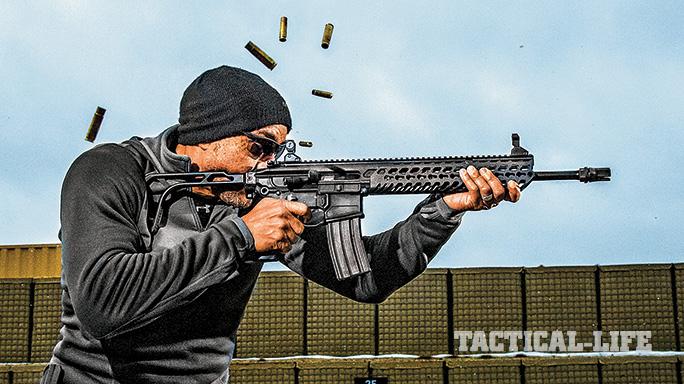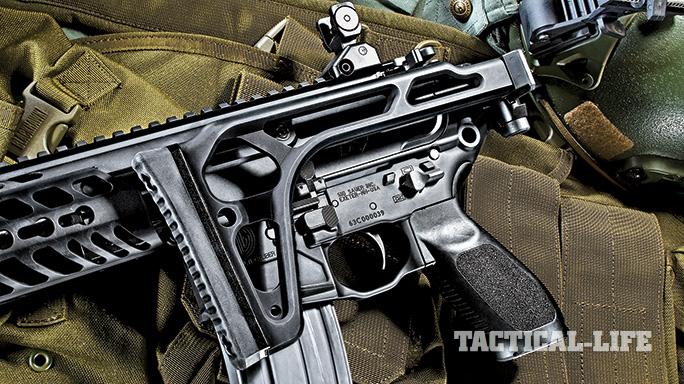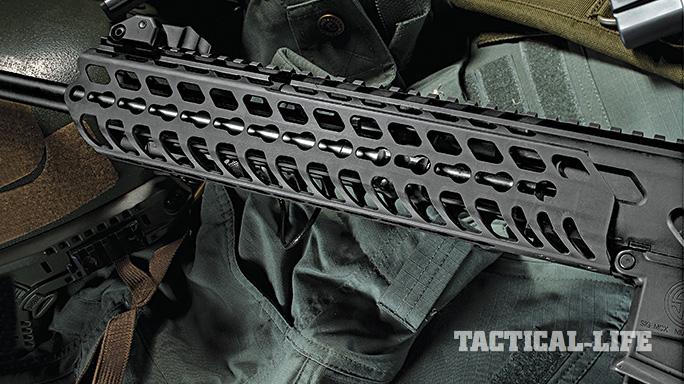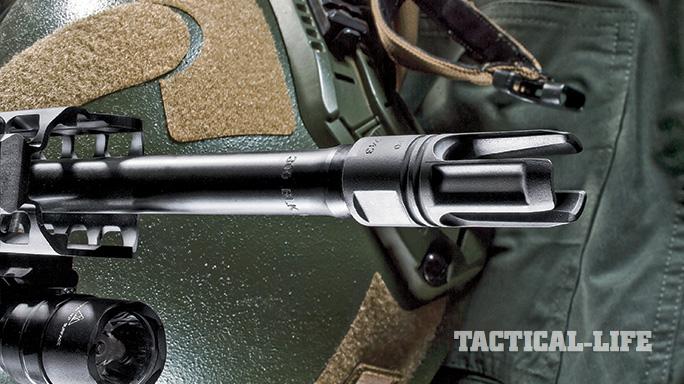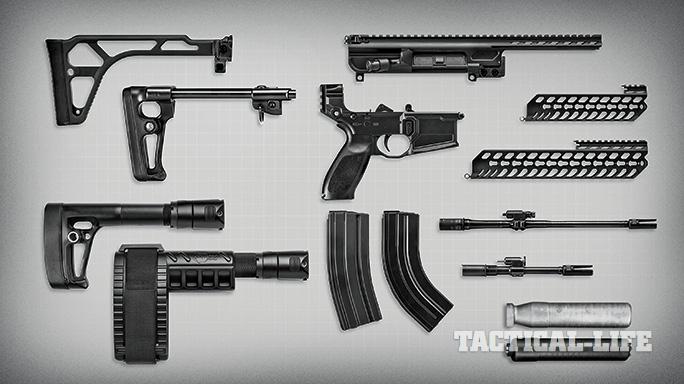Entirely new weapons systems are difficult to come by. The AR platform is the mainstay and the prevailing core of any American firearms innovation, and while it is a great platform, the inability to move beyond the AR may signal a lack of new ideas. Or maybe it’s a sign that the AR platform is one of few that is optimal for continued variant development. The current direction of weapons development may be primarily dictated by tighter budgets, which are reserved for funding operator training and replacing complete weapons and parts. So, operator familiarity and parts compatibility/commonality become very important and necessary traits in any platform. However you view it, it’s clear that AR-based weapons systems will be around indefinitely; future innovations may come in the form of redesigns and enhancements as opposed to completely original ideas and designs.
There is room for much improvement here, however, and Sig Sauer seems to have capitalized on that opportunity by unleashing the MCX, a new weapons system that harnesses technology the company has been perfecting for the past several years.
The MCX was designed from its inception as a complete, modular weapons system to be chambered for and to exploit the benefits of the 300 Blackout cartridge to include, as a forethought, suppressed shooting. Sig Sauer claims that no other weapon has been designed this way from the start. The company’s engineers also focused on the platform’s weight and modularity. Sources within Sig divulged that certain customers with certain credentials asked for a weapons system to replace their current weapons. It needed to be as quiet as an HK MP5SD when suppressed and chambered in 300 BLK as a starting point.
Advertisement — Continue Reading Below
Piston Driven
Arguably one of the least attractive traits of the AR is the standard direct impingement system. The MCX is based on Sig’s short-stroke gas piston operating system. This piston system is not like those currently on the market. It actually uses a unique dual return spring/single operating rod system. And it is auto-regulating. The piston position is able to self adjust based on system pressure. This design means the operator can shoot suppressed and non-suppressed, mixing subsonic and supersonic ammunition, without penalty. It’s difficult to get a gas system to run reliably in all of those varying scenarios, but this ability resides within the MCX.
The MCX sports many features that are likened to the AR, but with some interesting differences. The bolt has the same AR-15 anatomy from the bolt face to the cam pinhole. The MCX’s bolt is also same overall length as an AR-15’s, but the MCX’s lacks gas rings, so the width of the bolt body continues rearward slightly farther, then immediately notches down to form the tail end. It locks and closes completely during its rotation, and both the bolt and carrier are nickel-boron coated. The carrier is shortened to 3.5 inches and weighs 5.2 ounces, and it’s the same diameter as its AR siblings. The operating rod attaches to the top of the carrier via a notch cut into the carrier, and the whole thing is cycled by dual return springs riding on guide rods that are secured to the operating rod.
Advertisement — Continue Reading Below
- RELATED STORY: Sig Sauer Introduces the Cutting-Edge MCX For 2015
Could this be what a piston-driven AR was always meant to be? Yes, there are more parts here, but the system is very simplistic once you see it, and then you’ll get a good understanding of how Sig rethought the MCX’s design and function.
The MCX has the familiar AR upper and lower receiver layout that we know, but some caveats have been added here. The upper receiver is hardened in select areas, and Sig has developed replaceable parts for those areas that wear the most. One such part is the metal cam-path insert on the side of the upper receiver. Other replaceable parts include a feed ramp insert and the ambidextrous charging handle latch. These items are all steel inserts or pins. The forward assist has an aluminum housing that can be replaced if it wears out. These features reveal that the MCX was meant for long-term use in harsh conditions. In essence, you won’t have to scrap the upper receiver after hard use, only replace some parts. The lower receiver’s controls require no retraining, as they are the same as an AR’s, while the magazine release, bolt release and safety selector are all ambidextrous. Aftermarket drop-in triggers will be right at home, too.
Redefining Modularity
Advertisement — Continue Reading Below
“Modularity” is a term that is thrown around frequently, and the MCX is likely one of the truest examples of that term. The upper receiver is a monolithic design with a long, continuous top rail. The upper is also designed to accept handguards of different lengths. Currently, Sig offers short and long models. These KeyMod handguards are designed with different inner diameters so that they can fit over a sound suppressor if desired, or you can opt for the smaller-diameter handguard. They are also available in carbon fiber. The longer handguard acts as a continuation of the one-piece, 13-inch top rail, giving you over 17 inches of top rail to work with. Of course, these KeyMod handguards will accept a myriad of accessories available from Sig, such as vertical foregrips and sling plate adapters.
Operators can quickly interchange barrels by loosening two screws on the upper receiver. Both 9- and 16-inch barrels are available, and you can quickly change from 300 BLK to 5.56mm NATO with a barrel/operating rod swap. The 300 BLK barrels have 1-in-6-inch twist rates, while the 5.56mm NATO barrels have 1-in-7-inch twist rates. A 1-in-9.5-inch-twist 7.62x39mm barrel is also available, though it also requires you to change out the magazine. Civilian model barrels will get a nitride coating regardless of their length or caliber. Military/LE barrels can be chrome lined or nitrided depending on the customer’s requirements.
The lower receiver accepts STANAG-pattern magazines, but it’s also configurable like the rest of the rifle. There is no buffer tube like that of the AR. Instead, an attachment point resides at the rear of the receiver. This attachment point allows for different stocks to be fitted. You can choose from a side-folding, skeletonized SAS stock; a tubular, side-folding stock; or a telescoping stock. If you want to go the pistol route, Sig also offers its SBX Stabilizing Brace as an option.
Advertisement — Continue Reading Below
Also, it should be noted that the MCX’s upper is compatible with any standard mil-spec AR-15 lower, and Sig offers a kit to convert such a lower to accept the different stocks by eliminating the buffer tube. So, LE agencies, for example, can more easily upgrade their current inventory with the MCX.
Silent Striker
Sig Sauer has been relentless in the development of its own line of “Silencers.” As mentioned before, the MCX was designed around suppressor use, as a complete weapon system, and it is specifically optimized to work with Sig’s cans.
Advertisement — Continue Reading Below
Sig’s SRD Silencers are technologically advanced and offer excellent sound reduction, durability and light weight. With their Taper-Lok Fast Attach muzzle devices, you can opt for an SRD762-QD and have every caliber of the MCX covered, as it is rated to handle up to .300 Winchester Magnum cartridges. The SRD762-QDTi, a titanium version, is also available. It is a slightly larger can than the SRD762-QD, but this offers more volume in the Silencer for greater sound reduction. Because of the Grade 5 titanium construction, it is lighter than the 718 Inconel SRD762-QD by 1.2 ounces. You can also opt for a 5.56mm NATO-specific suppressor like the SRD556, SRD556-QD or SRD556-QDTi if you’re confident that you’ll only be running 5.56mm NATO ammo through your MCX.
Although the MCX is ideally paired with Sig Silencers, the company informed me that the MCX will run properly with the suppressor brand of your choosing because it is backwards compatible with traditionally designed 1/2×28- or 5/8×24-threaded muzzle devices.
Full-Auto Blackout
Advertisement — Continue Reading Below
I was able to shoot two select-fire versions of the MCX while at the Sig Sauer Academy in Epping, New Hampshire: a 16-inch-barreled carbine and a 9-inch-barreled SBR. For this test, I used Sig’s own Elite Performance 220-grain, subsonic 300 BLK ammo. I ran this load both suppressed and unsuppressed without issue.
The MCX has a light recoil impulse, and it was easy to make quick follow-up shots. I was most impressed at how controllable the MCX was when firing on full-auto. It’s certainly not a spray-and-pray weapon. Instead, it feels like you can simply guide the rounds exactly where you want them to hit. Of course, this might be different with supersonic ammo. I attached a SRD762-QDTi suppressor to the MCX, and it became very quiet. With the Silencer attached, the loudest part was the round hitting the backstop.
I was not able to formally test the MCX’s precision, but my test carbines were at least combat accurate off-hand, and I can see shooters obtaining sub-MOA results. In fact, I have personally witnessed the MCX SBR shoot sub-MOA groups at 100 yards. The actual accuracy requirement for the MCX during development was 2 MOA at 100 yards with subsonic ammunition. The prototype MCX met that requirement with a 6.75-inch barrel.
Advertisement — Continue Reading Below
It’s obvious that Sig Sauer is quickly becoming a supplier of complete weapons systems, from firearms to ammunition, suppressors, sights and other accessories. This may not be a new concept, but it is advantageous for you to have a company like Sig Sauer backing up your new platforms over the long term.
- RELATED STORY: New For 2015: Sig Sauer Unveils Next-Gen SIG MCX
Building the MCX from the ground up as a suppressor-ready platform specifically for the 300 BLK is promising, and it shows that the 300 BLK is only moving forward. The fact that the carbine can be quickly switched to 5.56mm NATO or 7.62x39mm, or to an SBR with a side-folding stock, for example, is just icing on the cake.
I’m aware that the MCX has been used in theater, and the reports on its functioning have been positive.
Advertisement — Continue Reading Below
For more information, visit sigsauer.com or call 603-610-3000.
